Stylish and quite practical covering - laminate - quickly conquered the market with its positive qualities. It is easy to take care of it, and it is very convenient to use. But you need to know that the lion's share of its appearance and durability is determined by the quality of installation, and not the last question here is which substrate to choose for the laminate.
- What is the backing for?
- Substrate thickness
- Polyethylene foam (isolone)
- Cork substrates
- Expanded polystyrene
- Coniferous tiles
- Foil backing
- Combined underlays
- Laying the underlayment under the laminate
What is the backing for?

The lining under the laminate must be installed in connection with the tasks assigned to it:
- Soundproofing. If no substrates are placed under the laminate flooring, the sounds will be amplified by the wood or concrete base with each step. With the help of an even soft base, you can get rid of squeaks and small noises. In the 32nd and 33rd classes of laminate, sometimes there are built-in substrates in the form of insulation glued on the back side. It is easier to lay such a material than usual, but a more complex technology for its production significantly increases its price.
- Surface leveling is another task that the laminate backing sheet must cope with. When installing this coating, it is very important to level the surface, since the durability of the locks will depend on this. The laying technology allows a height difference of 1 m not more than 2 mm. But a too thick substrate, well hiding irregularities, will, at the same time, bend strongly under the weight of steps. To prevent the seams from spreading after six months, the floor surface must be carefully prepared before laying the laminate.
- Waterproofing. Laminate is just pressed paper, so even its most moisture-resistant models should not be tested by pouring water, otherwise its panels will simply swell. A laminate underlay on a concrete floor is able to protect the coating from moisture coming from the cement base. In general, the concrete screed should be given a month to dry and only then the topcoat should be laid. You can check the readiness of the screed by laying a plastic wrap on its area overnight. If there is no perspiration on it in the morning, then the screed is dry.
- Thermal conductivity. A substrate for a laminate, located above a warm floor, will inevitably reduce the efficiency of its work, since both it and the coating itself have a rather low thermal conductivity. Although, for the installation of underfloor heating, they began to make special substrates. In any case, regardless of the material of manufacture, the thickness of the substrate laid under the laminate should not be more than 3 mm. True, there are unscrupulous craftsmen who, trying to hide their own shortcomings when leveling the base, use thick linings (4-5 mm). Such an object looks perfect upon delivery, but six months later, the laminate begins to creep at the seams.
Substrate thickness

You need to be able to choose the right substrate that will work perfectly with the laminate. Different substrates have a lot of differences in thickness, material and degree of sound insulation. Before deciding which is the best substrate for the laminate, you need to assess the condition of the floor:
- If the base is even, then the thinnest ( 2 mm) of the substrate.
- If small irregularities remain on the base, then you will need 3 mm insulation.
- The total thickness of the backing with the laminate is about 10-11 mm - if using a medium thickness (8 mm) material.
Some users believe that the thicker the backing is placed under the laminate, the better. Some do not even skimp and lay substrates of standard thickness in two layers to enhance the effects of thermal insulation and noise insulation. But at the same time, they do not take into account that the load on the floor is almost always uneven - where there is furniture or a person, it is significantly greater than next to this place.
As a result, a substrate that is too thick is more likely to be crushed, which may even break the laminate planks.
Even if the substrate is only slightly thicker than the prescribed 3 mm, then the lamella locks will be damaged over time, because the laminate is not designed to bend under the weight of a person. As a result of the wear of the locks and the deflection of the planks, noticeable gaps appear, and the floor will begin to creak louder and louder. Conversely, if the substrate is sufficiently smooth, then it makes sense to use a thinner substrate.
It makes no sense to buy a substrate from the same manufacturer that produced the floor covering itself - the substrates of any manufacturer are completely interchangeable.
Laminate backing materials
Polyethylene foam (isolone)

Foamed polyethylene does not have great strength and easily breaks under load and quickly compresses. Therefore, the insulating underlayment for the laminate is one of the cheapest available on the market.
Advantages:
- It is moisture resistant.
- It is not afraid of mold, mildew, and is not to the taste of rodents.
- Has good soundproofing properties.
- It is quite easy to lay it, connecting it with ordinary stationery tape, and you can do with almost no waste.
- Sometimes it is produced duplicated with aluminum foil so that it can reflect heat radiation.
- Izolon smooths well on the basis of unevenness.
- Immune to many chemicals.
Disadvantages:
- Short-lived. After one or two years, it loses its shape, elasticity and ceases to work as a damper, depriving the laminate of support.
- If the isolon was stored for a long time before being sold in direct sunlight, then it undergoes destruction and crumbles to dust.
- A serious drawback of foamed polyethylene is its ability to accumulate static electricity, therefore, in dry rooms, when the heating is on in winter, the laminate often "charges" people with sensitive electrical discharges.
Therefore, you should not especially chase cheapness and save not God knows what a large amount, risking comfort. At the same time, a choice remains: to buy imported polyethylene foam, for example, from Quickstep, or to prefer domestic, which costs four times cheaper.
Cork substrates
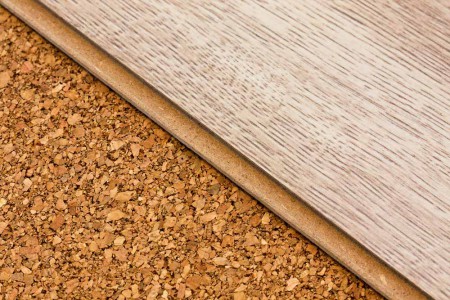
A cork backing for a laminate is best suited for a nursery. Cork backing is available in rolls or sheets. Sometimes you can find such a material with a self-adhesive layer.
Pressed cork backing is an expensive material, so it is impractical to combine it with cheap floor coverings, because it itself can serve as a durable base. There are several types of cork substrates on sale:
- cork with rubber;
- cork with bitumen;
- cork chips.
Advantages:
- The cork has wonderful elastic properties - being compressed by serious loads, after being released from them, it is able to restore its original shape. Therefore, no matter how often and no matter how intensively children play in a room where a cork is laid under the laminate, you don't have to worry about its safety and integrity.
- Due to its very low thermal conductivity, cork material provides excellent thermal insulation, which is why we can say that cork is the warmest substrate for laminate flooring.
- Its significant resilience also prolongs the life of the laminate, as it protects its locks from strong kinks.
- Cork underlays are an excellent base for installing a floating floor.
- Despite its natural nature, cork is not afraid of rot and mold.
Disadvantages:
- Although the cork substrate is not afraid of moisture, it allows it to pass quite easily, so moisture can accumulate under the cork coverings.
- Due to the high density of the cork, it cannot be laid on the bases, the surfaces of which are not sufficiently leveled and have deviations in height of more than 2 mm, therefore, the screed under it must be perfectly leveled.
In fact, cork is the best substrate for laminate flooring, although it is not without its drawbacks, the main of which is its high cost, and less significant - insufficient resistance to moisture.
Bituminous cork substrates
As for the bitumen-cork substrate, it is made of kraft paper, poured with an even layer of bitumen and sprinkled with cork chips, the particles of which are 2-3 mm in size.
It passes air well, but at the same time condensation does not form under it, since the bituminous layer becomes a reliable protection against its appearance.
However, laying the substrate under the laminate and in such its component composition will be very expensive, so it is rational to use it only with the most expensive types of laminate.
Expanded polystyrene
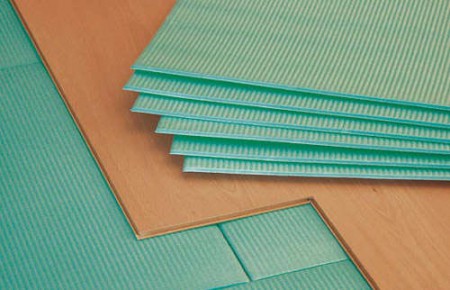
The domestic industry has established the production of a substrate made of extruded polystyrene foam, which in the domestic market has become one of the most popular solutions for those who need a 3 mm laminate substrate. Its trade name is "isoise". Its constituent expanded polystyrene not only possesses all the advantages of polyethylene foam, but surpasses them many times.
"Izoshum" is produced in square sheets with sides of 1 m, and the package contains 10 such sheets. A very large proportion of air in its structure makes it an effective insulation. The rigidity of polystyrene allows the product to keep its shape. When walking on the floor, under which the foam polystyrene substrate is located, there will be only pleasant sensations and no "recharging" with electricity, as in the case of polyethylene foam. Besides isoise, another well-known trademark made of the same material is Arbiton.
Advantages:
- Isoise has excellent sound and heat insulating characteristics. Owners of private houses willingly use it when laying laminate flooring, because they are especially interested in saving heat. In apartments of multi-storey buildings, the sound-insulating properties of "isnoise" will also be valuable, since it effectively absorbs impact sounds with a force of up to 27 dB.
- After walking on polystyrene foam for a long time, it will not be compressed like flimsy polyethylene foam, since it has a denser structure.
Thanks to these qualities, it is excellent for use in rooms with high traffic.
Disadvantages:
- If at first in some qualities it surpasses even the famous roll cork, then after a few years these qualities are "blown away", that is, we can talk about insufficient durability of the material.
- In the event of fire and ignition, polystyrene releases a lot of toxic compounds, while also contributing to the rapid spread of the flame.
- Its leveling capacity is not high enough, therefore, for example, a 2 mm laminate underlay requires a perfectly flat base.
Coniferous tiles
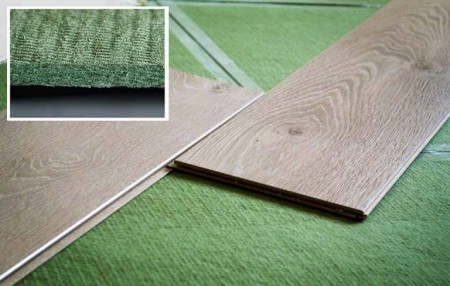
In recent years, another novelty has appeared - a coniferous substrate under the laminate. It is still very expensive, it is practically impossible to find it in stores, but if someone comes across the name "Isoplat" on the counter, then this is it. The novelty is advertised as an exceptionally environmentally friendly material that "breathes" well, so it will not suit the greenhouse effect under the floor covering.
But from the point of view of elasticity, it is still significantly inferior to the classic cork.
It should also be taken into account that coniferous tiles have a minimum thickness of 4-5 mm, which conflicts with the requirements of the manufacturers of the laminate itself.
The wooden underlayment for the laminate comes in the form of tiles that must be laid diagonally.
Foil backing
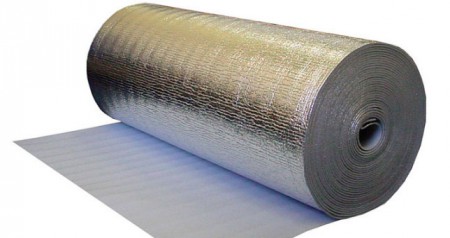
This material is appreciated for the fact that it is able to perfectly retain heat. On sale you can find one-sided or double-sided types of foil substrates, consisting of two layers: foil and polyethylene foam or polystyrene.
The foil backing is ideal for rooms where there is a possibility of moisture penetration into the screed (bathroom, kitchen, basement).
Advantages:
- The thermal insulation of the floors is increased by 30%.
- It is an additional waterproofing layer.
- Increased moisture resistance, so that an additional layer of polyethylene film is not needed.
- Prevents mold and mildew growth.
Combined underlays

Quite interesting is the material in which polystyrene foam and polyethylene are present at the same time. For example, in the well-known trade mark Tuplex, foam polystyrene balls are located between two layers of polyethylene. In this case, the thickness of the substrate for the laminate is standard 3 mm, and the material itself is sold in rolls. Due to its structure, this material allows the room to be ventilated. The top layer does not allow moisture to pass through, and a very thin bottom layer allows it to pass to the bubbles, from where it is discharged out through the technological gaps.
There are other combinations, for example, some manufacturers produce a laminate to which rubber is glued from below, covered on the opposite side with a thin non-woven material. On the screed, it glides well, without warping, and while walking, it perfectly absorbs noise. Of course, the cost of such an "advanced" laminate is much higher than the usual one.
Substrate under the laminate on a warm floor
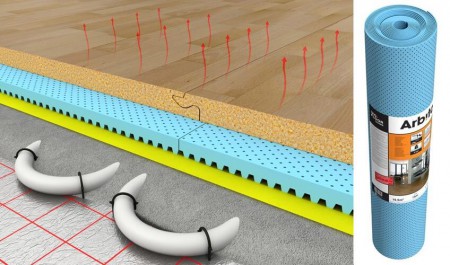
Even in cases where the laminate is laid on an underfloor heating that cannot be wet by definition, then even then a special underfloor for the underfloor heating is required.
Therefore, a special material Arbiton was developed for underfloor heating, which has a fine perforation, due to which it allows heat to pass through almost unhindered, but perfectly copes with the main function of supporting the laminate.
You can also use polyethylene without foil, and in the most extreme case, even use a simple corrugated cardboard, because on a dry floor in the complete absence of moisture, even such an extravagant solution can work. Since the laminate itself does not conduct heat well, it is necessary to use specially made brands for flooring over a heated floor.
Laying the underlayment under the laminate
Laying the underlayment under the laminate consists of the following steps:
- A thin plastic wrap must first be laid on a fresh concrete screed, but for old screeds, this step can be skipped.

- All dirt and dust should be removed from the floor by working with a vacuum cleaner and making sure that the base is dry.
- You can cut the substrate with a construction knife or ordinary scissors.
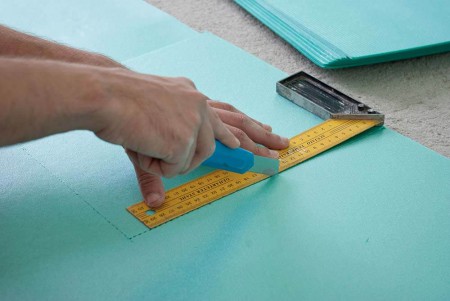
- If the backing material allows, an overlap should be made on the walls, which will then be hidden under the skirting boards.
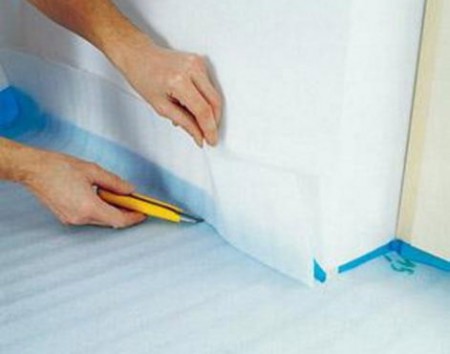
- In an attempt to compensate for unevenness, you cannot duplicate the underlay layers. Alignment can only be carried out with screed, plywood or other acceptable means.
- If the substrate has corrugation, then it should be facing downward, then there will be less irregularities.
- Foil materials should be laid with reflective side up.
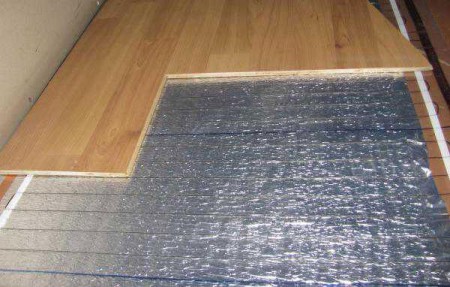
- Laying must be done end-to-end, without overlapping the sheets.
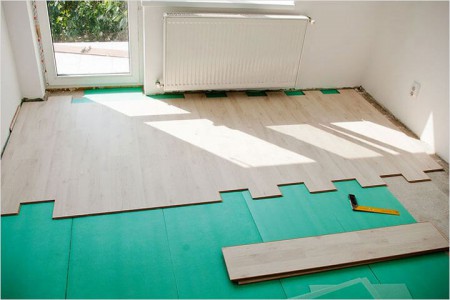
- To prevent the substrate from accidentally shifting during operation, it can be fixed with double-sided tape to the floor.
Video about laying a foil underlay under a laminate:
What kind of laminate underlay do you prefer and why? Share your experience and opinion in the comments - we are interested in your opinion.



